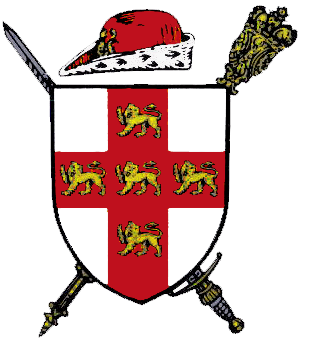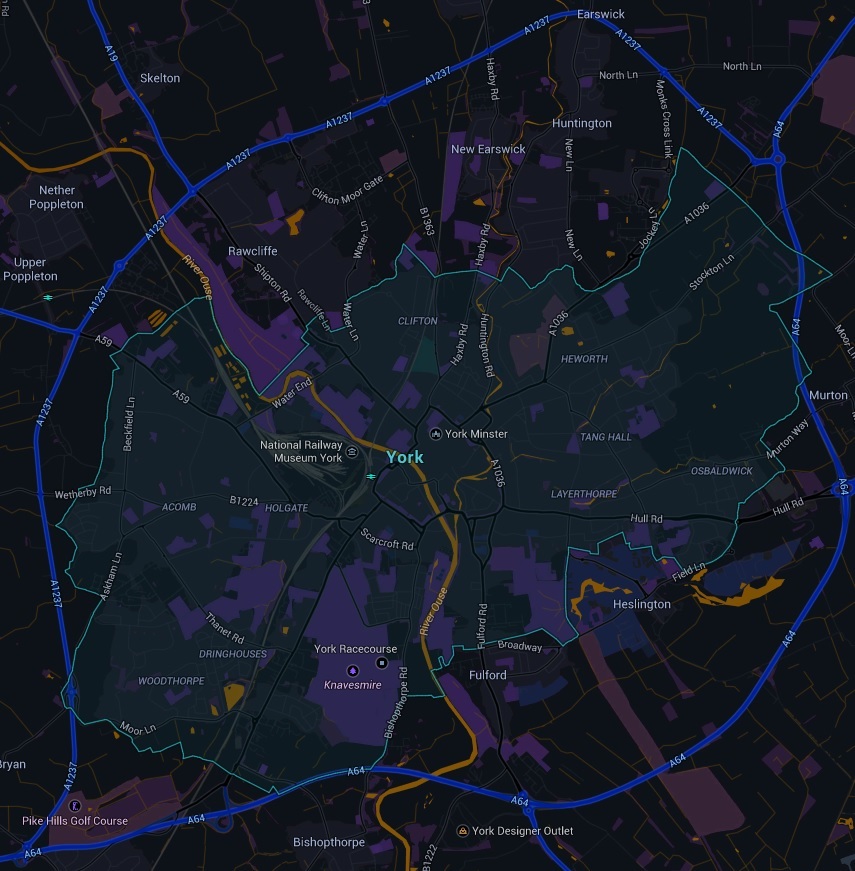Difference between revisions of "York"
(→Districts) |
(→Districts) |
||
| Line 14: | Line 14: | ||
* -- [[Fulford - York]] | * -- [[Fulford - York]] | ||
* -- [[Layerthorpe - York]] | * -- [[Layerthorpe - York]] | ||
| − | * -- [[Osbaldwick - York]] | + | * -- [[Osbaldwick - York]] -- Osbaldwick is a village and civil parish; it has been in existence since at least the 11th century, and was declared a conservation area in 1978. It is the burial place of the nun Mary Ward. |
* -- [[Tang Hall - York]] | * -- [[Tang Hall - York]] | ||
Revision as of 11:54, 3 March 2015
Contents
- 1 Quote
- 2 Appearance
- 3 City Device
- 4 Climate
- 5 Districts
- 6 Demonym
- 7 Economy
- 8 Geography
- 9 History
- 10 Location
- 11 Population
- 12 Arenas
- 13 Attractions
- 14 Bars and Clubs
- 15 Cemeteries
- 16 City Government
- 17 Crime
- 18 Citizens of the City
- 19 Current Events
- 20 Fortifications
- 21 Galleries
- 22 Holy Ground
- 23 Hospitals
- 24 Hotels & Hostels
- 25 Landmarks
- 26 Maps
- 27 Mass Media
- 28 Monuments
- 29 Museums
- 30 Parks
- 31 Private Residences
- 32 Restaurants
- 33 Ruins
- 34 Schools
- 35 Shopping
- 36 Telecommunications
- 37 Theaters
- 38 Transportation
- 39 Vampires of the City
- 40 York's Restless Dead
- 41 Websites
- 42 Stories of the Sword and Scepter
Quote
Appearance
City Device
Climate
York has a temperate climate with four distinct seasons. As with the rest of the Vale of York the city's climate is drier and warmer than the rest of the Yorkshire and Humberside region. Because of its lowland location York is prone to frosts, fog, and cold winds during winter, spring and very early summer. In summer the average maximum temperature is 22 °C (72 °F) although some days can see highs of up to 30 °C (86 °F) rarely exceeding 32 °C (90 °F). Nights are significantly colder averaging minimum of 15 °C (59 °F), although these can consistently dip below 10 °C (50 °F). The average daytime temperature in winter is 8 °C (46 °F) and 2 °C (36 °F) at night. Snow can fall in winter from December onwards to as late as April but quickly melts. The wettest months are November, December and January with an average of 17 days per month with rainfall more than 0.25 millimetres (0.01 in). From May to July, York experiences the most sunshine, an average of six hours per day. Extremes recorded at the University of York campus between 1998 and 2010 include a highest temperature of 34.5 °C (94.1 °F) (Monday 17 July 2006) and a lowest temperature of −16.3 °C (2.7 °F) (Monday 6 December 2010). The most rainfall in one day was 88.4 millimetres (3.5 in).
Districts
- -- Fulford - York
- -- Layerthorpe - York
- -- Osbaldwick - York -- Osbaldwick is a village and civil parish; it has been in existence since at least the 11th century, and was declared a conservation area in 1978. It is the burial place of the nun Mary Ward.
- -- Tang Hall - York
Demonym
Economy
Geography
History
Since the coming of William the Conqueror and the partitioning of the isles into England, Scotland and Wales, York has been the bastion of English power in the north. No matter that it had little in the way of natural resources or industry, the English crown ensured that York remained strong and vital. Over the centuries, it was sacked by Scottish armies several times, and re-sacked more than once by retaliating English troops. It regularly hosted strong garrisons, both as threats of force, and to serve as the base for invasions of England's northern neighbor.
The Act of Unification with Scotland (late 17th century) changed all of this, and York began a long, slow decline. Centuries of history have not been able to preserve York's prestige as the bastion of the north: its neighbors, better positioned for trade and transportation, though less well defended by natural barriers, have far surpassed it in size and economy. York is now a backwater, thick with historical monuments and Northern England's premier university. However, Academia and tourism are the only real sources of employment here, and the city's young usually end up moving away in hope of a better future.
Location
The city is 21 miles (34 km) from Leeds.
York lies in the Vale of York, a flat area of fertile arable land bordered by the Pennines, the North York Moors and the Yorkshire Wolds The city was built at the confluence of the Rivers Ouse and Foss on a terminal moraine left by the last Ice Age.
During Roman times, the land surrounding the rivers Ouse and Foss was marshy, making the site easy to defend. The city is prone to flooding from the River Ouse, and has an extensive (and mostly effective) network of flood defences with walls along the river, and a liftable barrier across the River Foss where it joins the Ouse at the 'Blue Bridge'. In October and November 2000 York experienced the worst flooding in 375 years with more than 300 homes flooded. Much land in and around the city is on flood plains too flood-prone for development other than agriculture. The ings are flood meadows along the Ouse, while the strays are open common grassland in various locations around the city.
Population
- -- City (197,800) - 2009 census
- -- City (140,000) - 2029 census
Arenas
Attractions
- -- All Saints' North Street
- -- Lord Burlington's Assembly Rooms
- -- Bar Convent Museum
- -- Barley Hall run by York Archaeological Trust
- -- Bootham Bar, the Roman gate and still one of the four Bars into York
- -- Bridges of York
- -- Clifford's Tower
- -- DIG: an archaeological adventure
- -- The Shambles
Bars and Clubs
- -- Black Swan, pub
- -- Blue Bell, pub
- -- Sword and Scepter -- Medieaval Tavern located in the Shambles.
Cemeteries
City Government
Crime
Citizens of the City
Current Events
Fortifications
Galleries
Holy Ground
Hospitals
Hotels & Hostels
Landmarks
Maps
Mass Media
Monuments
Museums
Parks
Private Residences
- -- Mansion House -- is the home of the Lord Mayors of York during their term in office.
- -- Treasurer's House
Restaurants
Ruins
Schools
Shopping
Telecommunications
Theaters
Transportation
Vampires of the City
- Brian O'Reilly - Prince of York and Baron of Yorkshire,founder of the Knights of the World Tree
- Aras Valdemaras -- Eldest childe of the Baron Brian O’Reilly.
- Bronius Gintaras - Childe of Brian O'Reilly and Hero of Avalon
- Hans Holgersson - Fledgling Childe of Brian O'Reilly
- Daumentas Skuodzius - Fledgling Childe of Bronius Gintaras
The Dead or Missing
- Namia Vincent - Ventrue Reve of York (vassal of the Baron of York, based in Leeds) (deceased?)
- Michael Ogden Davies - Childe of Namia Vincent (deceased -- circa 2031)
York's Restless Dead
York was important and powerful for most of two millennia, and its Hierarchy presence reflects this, rather than York's current status as a sleepy university town. Most buildings within the old city are haunts, laden with centuries of pathos. The city's power blocks are old and well-entrenched, but somehow, there is room between the cracks for a few newcomers.
William Wolfsblood - A man who owes a life to Brian O'Reilly.
Richard the Jackal - A young doppleganger with a vendetta.
Little Willy - A skilled courier serving eternal penance.
Websites
http://en.wikipedia.org/wiki/York
http://www.york360.co.uk/panoramas-of-york-3.htm
Stories of the Sword and Scepter

